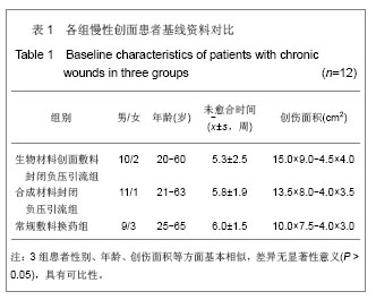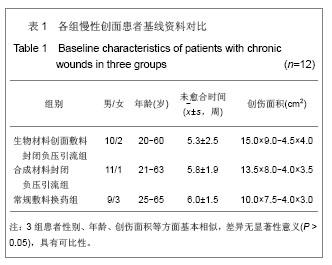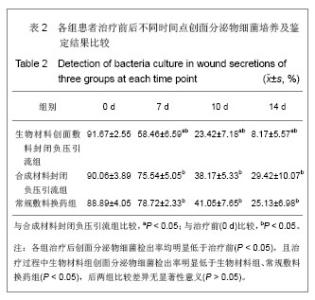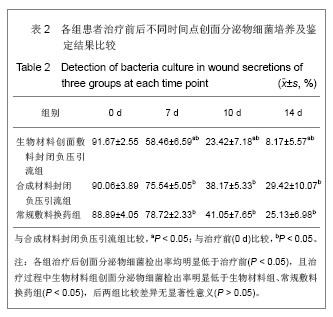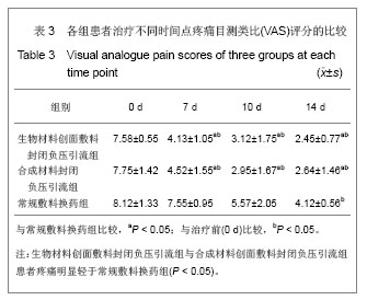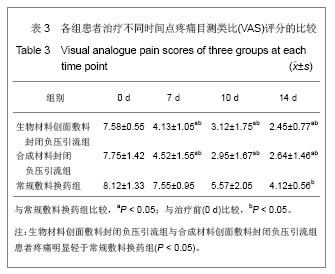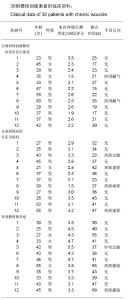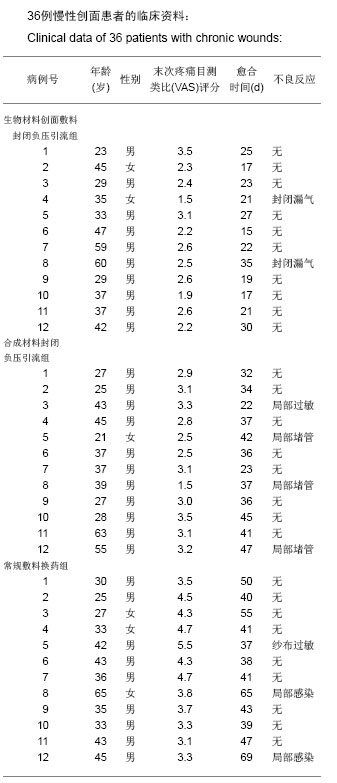Chinese Journal of Tissue Engineering Research ›› 2013, Vol. 17 ›› Issue (16): 3026-3032.doi: 10.3969/j.issn.2095-4344.2013.16.025
Previous Articles Next Articles
Application of clearance flush vacuum-sealing drainage based on wound dressing in chronic wounds
Xu Hai-dong, Zhao Jian-ning, Lu Jun-hao, Chen Yong
- Department of Orthopedics, Nanjing General Hospital of Nanjing Military Region, Nanjing 210002, Jiangsu Province, China
-
Received:2012-06-27Revised:2012-07-26Online:2013-04-16Published:2013-04-16 -
Contact:Chen Yong, Master, Associate chief physician, Associate professor, Department of Orthopedics, Nanjing General Hospital of Nanjing Military Region, Nanjing 210002, Jiangsu Province, China 13813889089@163.com -
About author:Xu Hai-dong★, Master, Attending physician, Lecturer, Department of Orthopedics, Nanjing General Hospital of Nanjing Military Region, Nanjing 210002, Jiangsu Province, China Xuhaidong1980@163.com
CLC Number:
Cite this article
Xu Hai-dong, Zhao Jian-ning, Lu Jun-hao, Chen Yong. Application of clearance flush vacuum-sealing drainage based on wound dressing in chronic wounds[J]. Chinese Journal of Tissue Engineering Research, 2013, 17(16): 3026-3032.
share this article
| [1]Fu XB.Zhonghua Chuangshang Zazhi. 2004;20(8): 449-451.付小兵.进一步重视体表慢性难愈合创面发生机制与防治研究[J].中华创伤杂志,2004,20(8): 449-451.[2]State Council of the People’s Republic of China. Admininstratise Regulations on Medical Institution, 1994-09-01.中华人民共和国国务院. 医疗机构管理条例. 1994-09-01.[3]Ge XJ,Zhang HW,Shi JP,et al.Zhongguo Zuzhi Gongcheng Yanjiu.2012;16(3):539-542.葛小静,章宏伟,史京萍,等.藻酸盐银联合水凝胶敷料对慢性创面愈合的作用[J].中国组织工程研究,2012,16(3):539-542.[4]Li LY,Bai XD.Zhongguo Zuzhi Gongcheng Yanjiu yu Linchuang Kangfu. 2006;10(9):166-168.李凌云,白晓东.慢性皮肤溃疡的愈合与修复[J].中国组织工程研究与临床康复,2006,10(9):166-168.[5]Li XQ,Dan WH,Wang KJ,et al.Cailiao Daobao:Nami yu Xincailiao Zhuanji. 2009;23(1):374-377.李晓琴,但卫华,王康健,等.体表创面修复材料的研究进展[J].材料导报:纳米与新材料专辑,2009,23(1):374-377.[6]Hardin MO,Mace JE,Ritchie JD,et al. An experience in the management of the open abdomen in severely injured burn patients.J Burn Care Res.2012;33(4):491-496.[7]Benech A,Arcuri F,Poglio G,et al.Vacuum-assisted closure therapy in reconstructive surgery. Acta Otorhinolaryngol Ital.2012;32(3):192-197.[8]Gupta S. Optimal use of negative pressure wound therapy for skin grafts. Int Wound J.2012; 9 (Suppl 1):40-47.[9]De Brabandere K,Jacobs-Tulleneers-Thevissen D,Czapla J,et al. Negative-pressure wound therapy and laparoscopic omentoplasty for deep sternal wound infections after median sternotomy.Tex Heart Inst J. 2012;39(3):367-371.[10]Xu HD,Zhao JN,Lu JH,et al.Zhongguo Zuzhi Gongcheng Yanjiu. 2012;16(12):2189-2192.徐海栋,赵建宁,卢俊浩,等.基于生物材料创面敷料封闭负压引流在创伤性骨髓炎治疗中的应用[J].中国组织工程研究,2012, 16(12):2189-2192.[11]Fleischmann W,Streck W,Bombelli M,et al. Vacuum sealing as treatment of soft tissue damage in open fractures. Unfallchirurg.1993;96(9):488-492.[12]Penn E,Rayment S.Management of a dehisced abdominal wound with VAC therapy.Br J Nurs.2004;13(4):194-201.[13]Lindstedt S,Malmsjö M,Ingemansson R.Blood flow change in normal and ischemicmucardiam during topically applied negative pressure.Ann Thorac Surg.2007;84(2):528-573.[14]Malmsjö M,Ingemansson R,Lindstedt S,et al.Comparison of bacteria and fungus-binding mesh, foam and gauze as fillers in negative pressure wound therapy - pressure transduction, wound edge contraction, microvascular blood flow and fluid retention.Int Wound J.2012. [Epub ahead of print][15]Cigna E,Maruccia M,Sorvillo V,et al.The use of negative pressure therapy and hyaluronic acid for the management of post-traumatic lower limb injury.Int Wound J. 2012. [Epub ahead of print][16]Ito H,Arao M,Ishigaki H,et al.The use of negative pressure wound therapy to treat wound necrosis and groin lymphorrhea after inguinal lymph nodes dissection: a case report. Nihon Hinyokika Gakkai Zasshi.2012;103(1):22-26.[17]Danciu TE,Gagari E,Adam RM,et al.Mechanical stra in delive anti-aptotic and proliferative signals to gingival fibroblasts. Dent Res.2004;83(8):596-601.[18]Xu HD,Chen Y,Zhao JN,et al.Zhongguo Zuzhi Gongcheng Yanjiu. 2012;16(8):1505-1508.徐海栋,陈勇,赵建宁,等.基于生物材料创面敷料封闭负压引流在骨筋膜室综合症切开减压中的应用[J].中国组织工程研究, 2012, 16(8):1505-1508.[19]Xu HD,Zhao JN,Chen Y, et al.Zhongguo Zuzhi Gongcheng Yanjiu. 2012;16(12):2189-2192.徐海栋,赵建宁,陈勇,等.基于生物材料创面敷料封闭负压引流在创伤性骨髓炎治疗中的应用[J].中国组织工程研究,2012, 16(12): 2189-2192.[20]Xiong FM,Liu XY,Ge BF,et al.Zhongguo Jiaoxing Waike Zazhi. 2010;18(2):147-150.熊发明,刘兴炎,葛宝峰,等.封闭负压引流对早期处理爆炸创面的细菌和微循环的影响[J].中国矫形外科杂志,2010,18(2): 147-150.[21]Günter CI,Machens HG. New Strategies in Clinical Care of Skin Wound Healing. Eur Surg Res.2012;49(1):16-23.[22]Ansell DM,Holden KA,Hardman MJ.Animal models of wound repair: Are they cutting it?Exp Dermatol.2012;21(8): 581-585. [23]Senet P,Combemale P,Debure C,et al.Malignancy and Chronic Leg Ulcers: The Value of Systematic Wound Biopsies: A Prospective,Multicenter, Cross-sectional StudyMalignancy and Chronic Leg Ulcers.Arch Dermatol.2012;148(6):704-708.[24]Akita S,Yoshimoto H,Akino K,et al.Early experiences with stem cells in treating chronic wounds. Clin Plast Surg. 2012; 39(3):281-292.[25]Cutting K,White R,Mahoney P. Wound infection, dressings and pain, is there a relationship in the chronic wound?Int Wound J. 2012. [Epub ahead of print][26]He DP,Li SZ,Yin ZM,et al.Zhonghua Yiyuan Ganranxue Zazhi. 2006;16(2):177-179.何代平,李素芝,殷作明,等.高原和内地枪弹伤后细菌感染的对比研究[J].中华医院感染学杂志,2006,16(2):177-179.[27]Beno M,Martin J,Hatzl J.Vacuum sealing in the treatment and prevention of prosthetic infections--a case review. Rozhl Chir. 2010;89(8):508-512.[28]Labler L,Oehy K.Vacuum sealing of problem wounds.Swiss Surg.2002;8(6):266-272.[29]Liu L,Tan G,Luan F,et al. The use of external fixation combined with vacuum sealing drainage to treat open comminuted fractures of tibia in the Wenchuan earthquake.Int Orthop. 2012;36(7):1441-1447.[30]Tang J,Guo WC,Yu L,et al.Clinical efficacy of artificial skin combined with vacuum sealing drainage in treating large-area skin defects.Chin J Traumatol.2010;13(5):289-292.[31]Wolf SJ,Bebarta VS,Bonnett CJ,et al.Blast injuries.Lancet. 2009; 374:405-415.[32]Hofmann HS,Schemm R,Grosser C,et al. Vacuum-assisted closure of pleural empyema without classic open-window thoracostomy.Ann Thorac Surg.2012;93(5):1741-1742.[33]Siciliano RF,Waisberg DR,Samano MN,et al. Poststernotomy aspergillosis: successful treatment with voriconazole, surgical debridement andvacuum-assisted closure therapy. Clinics (Sao Paulo).2012;67(3):297-299.[34]Gudmundsdottir I,Steingrímsson S,Gudbjartsson T. Negative pressure wound therapy in Iceland – indication and outcome. Laeknabladid.2012;98(3):149-153.[35]Dowsett C,Davis L,Henderson V,et al.The economic benefits of negative pressure wound therapy in community-based wound care in the NHS. Int Wound J. 2012. [Epub ahead of print] [36]Matsushita Y,Fujiwara M,Nagata T,et al.Negative pressure therapy with irrigation for digits and hands: pressure measurement and clinical application.Hand Surg.2012;17(1): 71-75.[37]Dipaola CP,Saravanja DD,Boriani L,et al.Postoperative infection treatment score for the spine (PITSS): construction and validation of a predictive model to define need for single versus multiple irrigation and debridement for spinal surgical site infection. Spine J.2012;12(3):218-230.[38]Li TS,Choong MY,Wu HF,et al.Simplified negative-pressure wound therapy system for skin graft wounds.Plast Reconstr Surg.2012;129(2):399e-401e.[39]Lu XX,Chen SZ,Li XY,et al. Zhongguo Linchuang Kangfu. 2003;7(8):1244-1245.吕小星,陈绍宗,李学拥,等.封闭负压引流技术对创周组织水肿及血管通透性的影响[J].中国临床康复,2003,7(8):1244-1245.[40]Tan Q.Yixue Yanjiusheng Xuebao. 2011;24(2):113-116.谭谦.再生医学与组织工程[J].医学研究生学报,2011, 24(2): 113-116. |
| [1] | Li Li, Ma Li. Immobilization of lactase on magnetic chitosan microspheres and its effect on enzymatic properties [J]. Chinese Journal of Tissue Engineering Research, 2021, 25(4): 576-581. |
| [2] | Zhou Anqi, Tang Yufei, Wu Bingfeng, Xiang Lin. Designing of periosteum tissue engineering: combination of generality and individuality [J]. Chinese Journal of Tissue Engineering Research, 2021, 25(22): 3551-3557. |
| [3] | Gan Lili, Xiong Na, Liu Yanfei. Hydrogel as drug scaffold in skin wound repair: challenges of clinical application possibilities [J]. Chinese Journal of Tissue Engineering Research, 2021, 25(22): 3578-3583. |
| [4] | Lang Limin, He Sheng, Jiang Zengyu, Hu Yiyi, Zhang Zhixing, Liang Minqian. Application progress of conductive composite materials in the field of tissue engineering treatment of myocardial infarction [J]. Chinese Journal of Tissue Engineering Research, 2021, 25(22): 3584-3590. |
| [5] | Liu Jinlei, Yin Li, Zhang Yi, Wang Haitao, Li Zhuangyan, Xia Peige, Qiao Renqiu. Effects of intravenous tranexamic acid combined with periarticular multipoint injection of tranexamic acid cocktail on blood loss and pain after total knee arthroplasty [J]. Chinese Journal of Tissue Engineering Research, 2021, 25(18): 2833-2839. |
| [6] | Chen Zhenyu, Zhang Xiaoning, Luo Yuxin, Liang Jianwei, Yan Chi. Evaluation of silk fibroin/curcumin composite film for promoting wound healing [J]. Chinese Journal of Tissue Engineering Research, 2021, 25(16): 2554-2561. |
| [7] | Xie Jian, Su Jiansheng. Advantages and characteristics of electrospun aligned nanofibers as scaffolds for tissue engineering [J]. Chinese Journal of Tissue Engineering Research, 2021, 25(16): 2575-2581. |
| [8] | Ji Qi, Yu Zhengwen, Zhang Jian. Problems and trends of technique and clinical application of metallic biomaterials prepared by three-dimensional printing technology [J]. Chinese Journal of Tissue Engineering Research, 2021, 25(16): 2597-2604. |
| [9] | Qian Nannan, Zhang Qian, Yang Rui, Ao Jun, Zhang Tao. Mesenchymal stem cells in the treatment of spinal cord injury: cell therapy and combination of new drugs and biomaterials [J]. Chinese Journal of Tissue Engineering Research, 2021, 25(13): 2114-2120. |
| [10] | Jia Wei, Zhang Mandong, Chen Weiyi, Wang Chenyan, Guo Yuan. Effects of femoral prosthetic materials on artificial knee arthroplasty performance [J]. Chinese Journal of Tissue Engineering Research, 2021, 25(10): 1477-1481. |
| [11] | Wang Qian, Li Lu, Shu Jingyuan, Dong Zhiheng, Jin Youshi, Wang Qingshan. Micro-morphology and phase of zirconia-based nano-hydroxyapatite functional gradient biomaterials [J]. Chinese Journal of Tissue Engineering Research, 2021, 25(10): 1517-1521. |
| [12] | Huang Yong, Zhu Weimin, Lu Wei, Ouyang Kan, Peng Liangquan, Liu Haifeng, Li Hao, Feng Wenzhe, Xu Jian, Zhong Mingjin, Chen Kang, Li Ying, Deng Zhenhan. Safety of steroid-containing cocktail periarticular injection after knee arthroplasty: a meta-analysis [J]. Chinese Journal of Tissue Engineering Research, 2020, 24(9): 1449-1456. |
| [13] | Li Li, Ma Li, Li He. Preparation and characterization of magnetic chitosan microspheres [J]. Chinese Journal of Tissue Engineering Research, 2020, 24(4): 577-582. |
| [14] | Tang Mengmeng, Chen Hechun, Xie Hongchen, Zhang Yu, Tan Xiaoshuang, Sun Yixuan, Huang Yina. Histocompatibility of poly(L-lactide-co-ε-caprolactone)/cross-linked polyvinylpyrrolidone ureteral stent grafted into the rat bladder [J]. Chinese Journal of Tissue Engineering Research, 2020, 24(4): 583-588. |
| [15] | Deng Kaifeng, Chen Rilan, Zhu Shengwang, Wei Xingcheng, Zhang Lijuan, Zhu Ying. Electroacupuncture combined with thunder-fire moxibustion in the treatment of cold-dampness knee osteoarthritis: a randomized controlled clinical trial [J]. Chinese Journal of Tissue Engineering Research, 2020, 24(29): 4638-4642. |
| Viewed | ||||||
|
Full text |
|
|||||
|
Abstract |
|
|||||
